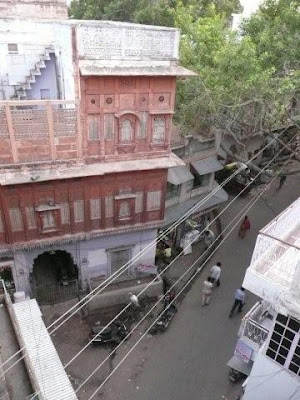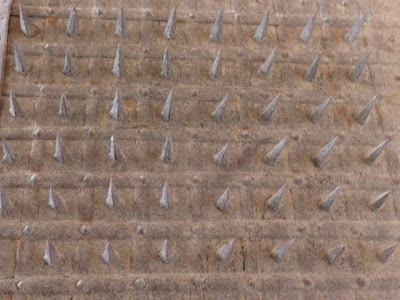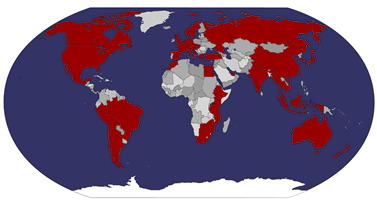
At the airport, we’re in but Air Deccan security won’t scan our bags for 20 minutes more. I use the time to investigate Retiring Rooms. These are rooms at the airport that you can use if you have a confirmed flight the following day. It’s 715r per night. We’ll probably use one before flying to Calcutta.
There’s an expensive restaurant upstairs which we don’t use, instead I use the time to call Heaven, the guesthouse recommended by Jesse, the chap we met in Air Deccan’s office in Leh. Finally through security and there is just a crap sandwich bar with almost no food or drink. Our flight is delayed 1hr. As you go though security, the army makes everyone put a tag on their bag – you know the kind you normally pick up as you check in, that you write your name and address on? Anyway, after the scan, someone stamps it with a rubber ink stamp which is barely legible. When we go at last out of the gate, another army chap looks at each tag to make sure it’s been stamped. The joke is, there’s nothing to stop you switching tags with any other bag, and any purple smudge would suffice. What does it achieve? Nothing.

Plane is a turboprop, a well-aged ATR, with a single hostess looking after us all. It’s a short flight till our intermediate stop in Jaipur, where again there’s a security palava. Is this your bag etc? This is a domestic flight, are they saying they don’t trust Delhi security?

Cracks or "features"?
Onwards to Jodphur. We’d like to fly straight to Jaisalmer but it’s close to the border with Pakistan, and therefore sensitive, so no commercial flights allowed in. At Jodphur there are lots of army types about, the airport appears to be an army base too, but they’re all about to play cricket, all in whites.
Out, and a friendly chap, Mr Jain, from Heaven guesthouse greets us. He takes us out, I assumed to his car, but no, to an auto-rickshaw that we’re sharing! It turns out cars aren’t allowed into the old town of Jodphur, though I certainly saw a few in my time there. The guesthouse is really tucked away, just below the fort.

Looking down from our room on to the street
We walk up to the top, and have a welcome drink, tea. It’s a nice view from here as the sun goes down.

The fort rises up above the city
I pop downstairs to our room but slip, and fall down the stone stairs on my backside and back. Ouch! I’m in pain all down my arm and derriere, I can hardly sit!

Flying kites from the rooftops
We ask whether we can keep the room the following afternoon for a few hours, till 6 or so, perhaps by paying half rate. He agrees that should be no problem, his wife deals with all of that, and she’ll be back late tonight.

We head out to have a wander. It’s certainly quite chaotic, but people are friendly, we get lots of hellos.

There are many shops with ceiling-high stacks of brightly coloured cloths – linen or saris I’m not sure. We walk to the station, then head into Mid View restaurant. It’s empty (bad sign) but has AC (over-rides any other concerns).
They’re actually really friendly, and we try local dishes, which are nice, if all made with too much oil.

They tell us about the local tradition of men wearing ear-rings to signify being married, though others have said this is not true. There is also much significance in the colours women wear here.
Colours
Turban colour can signify caste, religion and occasion. Rajputs traditionally wear saffron, signifying chivalry. Brahmins wear pink, Dalits brown and nomads black. Multi-colours are for festivals. White, grey, black or blue turbans are worn by Hindus to signify sadness, but these colours are also worn by Muslims. The way a turban is tied further indicates the wearer’s social class and origin.

Walking back, we pass hundreds of people sleeping on beds on the street, what on earth? Are they homeless or just enjoying natural AC? We randomly find our way back, and try to sleep in the warm noisy room.
Jodphur
First stop for some breakfast – we go to the Omelette Shop. Not the one in LP, but the other one, next to it.

The vicious world of omelettes
Why? Well he opened five minutes earlier, but also Vicky, for this is his name, turned out to be a very friendly and interesting chap.

Not going to run out of eggs

No mercy
Amazingly, we find a photo of Hiroshi, the chap we met in Darjeeling, in Vicky's guestbook, dating from the last time Hiroshi visited India!

It’s very hot already, only mid-morning.

Through the Clock tower, we pop into the Shri Mishrilal Hotel for their famous makhania lassi for 14 rupees.

My goodness! It’s wonderful! A delicious sweet creamy treat, flavoured with saffron and pistaccio, with a little spoon of cream on top.

Leaving, I see they do take away too. I’ll be back!

Down the main street, we look for a bus to Mandore Gardens. At the end, the police say go left, which turns out to be wrong, the buses stop on the right, just before the junction. On the right bus, but before it’s moved a fight breaks out between police and conductor! We realise the bus is going nowhere, and get off to look for another one, which comes along directly.

The gardens are a twenty minute ride, and are pleasant enough, but not in the 40s!


In Kashmir he'd be armed, and possibly an officer
There are long-tailed monkeys everywhere, which is interesting, though they hiss if you go anywhere near them and bare teeth, and I for one haven’t had my rabies jabs!

There are some nice temples, or rather tombs too, but we’d barely been there half an hour before we decided we couldn’t take the heat, so headed back to town.


Tea party

But we're not invited
On the way, we debate where to go to find AC? Back to Mid Town? Cinemas? It’s oppressively hot.

We are trapped by the Spice Guy on the main street, who show us his guest book and tells us all about all the international people he knows. This seems to be a favoured sales trick in Jodphur, everyone, even the guy who makes omelettes, has a book full of commendations. The omelette guy’s book is quite funny though, as many of the entries are laced with sarcasm or just plain strange! We pass the lassi place again, and I succumb. Then it’s fort time!
Jodphur Fort, Meherangarh, dominates the town, on a 125m hill with enormous high walls, still with cannon pointing out over the top.

Thuzar balks once she realises what’s in store. We get a break as some guy who makes nice thalis (apparently) shows us another damn book full of recommendations. But we’re not hungry! No excuse, he’s telling us so we can visit on the way down, as this is the only way. I resolve to find another way off the fort!

At the top there is a marvellous view. Most do drive up here. You have to be crazy or British to walk. The entry fee is a pricy 250r each. For this you get a useless map, and an audioguide which is actually very good and informative. For the privilege, one must surrender passport or other important ID. We use Thuzar’s – a Burmese passport isn’t much use to anyone anyway!

Walking inside through a series of gates, one finds a deep-terracotta latticed network of courtyards and palaces, all with well-presented exhibits.

How to stop elephants bashing your front door down
One of the gates, the Lohapol (Iron gate) has tiny tragic hand prints, sati marks, made by Maharaja Man Singh’s widows who threw themselves on a pyre in 1843. Still attracting devotion today, they are covered in red powder.

Jodhpur, the Blue City, is named after the blue houses (traditionally the Brahmin ones) that dominate the town, which sits at the edge of the Great Thar Desert.

Supposedly the blue repels insects, good to know in this, a “pink” area on the malarial map according to the Scottish NHS travel web site.



Founded in 1459 by Rao Jodha, chief of Rajput clan known as the Rathores. Rathore was known as Marwar, the Land of Death. The town grew up because of trade route carrying opium, sandalwood, dates and copper.


Girls still peek down from these balconies today

Akbar's sword

Also available at this year's Arms Fair in Docklands

There is a nice collection of Mughal art, though it's very hard to photo as most pieces are covered with glass.



Where the entertainment took place

Looking down over the town



For peeking without being seen

The end of the tour is in the courtyard and rooms used by women.



Look for the patterns in the windows
After the stifling heat of the mid-day, a wonderful wind picks up, a prelude to short but heavy rain. What a lovely cool breeze. We shelter in the expensive in-fort café, so have a pot of tea only. The chap brings along a small pot of tea and fills our two mugs with two cups of tea, milk and sugar already stirred in in the pot! This is the style of India! How can I drink tea without sugar ever again? Oh how Pippi’s going to laugh at me!


As we walk down, a couple of Indian families decide they want to take photos with us! Very strange experience! They’re content to just look at the picture on screen afterwards.

One veiled woman was clearly in turmoil as to whether to lift it for the photo – her friend next to her jabbed her and laughed, and it was lifted.



Walking away from the fort, two young lads were following us. We said hello, and exchanged names.

When we branched off to look at the Jaswant Thada, a milky-white memorial to Maharaja Jaswant Singh II, they asked whether “we are coming?”. Well it’s up to you!

His Master's Voice said.. guard the fort!
Down from there, a flash-looking chap wearing big sunglasses walks past: “Where are you from?” “England.” “I export to Tescos.”. And with that he strode off! Okay then, err, bye!


In general though everyone is so friendly, and they all want to take photos, to the point where I start pretending I don’t have a camera.



Transport choices

There obviously aren’t many tourists here – and it’s low season now – as the woman who runs Heaven says, there are lots of outbreaks of diseases at the moment, so no one wants to come. Gulp!

We randomly get back to Heaven by zig-zagging through small streets, have a wash, then get out of the room by 6pm – I’ve a strong suspicion that Mrs Jain is going to try to charge us for another night, and I don’t want to give her cause. As we move our bags out, she suddenly appears and asks us to leave them in the room. Good move, but I know the game too. I wait till she’s gone, then move them out anyway.

We’d said we would eat at the guesthouse, as Mr Jain told us how good his wife’s cooking was. She joined us for tea and we chatted. Even after the sun sets, it was still hot. Dinner when it came was nice, but had clearly not been cooked by her! A palak paneer and a vegetable curry, with rice, washed down with a Kingfisher.


Downstairs, we get the bill. She charges us for two nights. We talk about her children. She has two Nepali boys working about the place, but doesn’t seem to think much of them. I ask her where she found them, and she says they are everywhere, waving her hand dismissively.

Lovely Nepali chap
We walk to the station in the dark and heat. The internet place I had hoped to use was closed, so we carried on to the station. In front, an incredible sight – the forecourt and station concourse are filled with hundreds of people sleeping on the floor. Are they waiting for a train, or just sleeping here?

It’s baking hot, and we need somewhere to wait a couple of hours. Upstairs we find the Foreigner Tourist Office, it doesn’t have AC but at least some air moving from a box in the corner.

I pop out and use the internet for a short while. Back, the train is here already - an hour early for some reason. No wonder these trains take so long, if they sit around in stations for this long!
We’ve got to work out which carriage. Indian carriages have five digit numeric codes like 95574, the ticket has a two digit code like A1. There doesn’t appear to be any way of connecting the two apart from asking station staff, and there never are any about. Perhaps they only wear civvy clothes?
The dilemma is easily solved – there is only one AC carriage anyway! Our ticket is 3AC – exactly like the other ones but six bunks in the space four occupy in 2AC. These are all perpendicular to train direction, then outside there are single beds parallel. We jam our big bags under the bottom bunk as usual, then get comfy.
Soon we’re joined by a group of Indian middle-aged men. They are loud, and like all Indian med can’t control themselves around women. I don’t think Thuzar enjoys the stares. They keep talking, as I read my book. One asks if they can switch the light off. I say fine, and put my book down. Then they keep on talking!! Incredible.




No comments:
Post a Comment